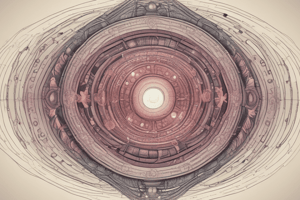Podcast
Questions and Answers
Where are ectodermal cells located in the chick embryo?
Where are ectodermal cells located in the chick embryo?
Which germ layer is responsible for forming the skeletal, muscular, and circulatory systems?
Which germ layer is responsible for forming the skeletal, muscular, and circulatory systems?
Where do mesodermal cells in the chick embryo originate from?
Where do mesodermal cells in the chick embryo originate from?
Which germ layer gives rise to the digestive and respiratory systems?
Which germ layer gives rise to the digestive and respiratory systems?
Signup and view all the answers
What serves as a signpost for the migration of cells that form the mesoderm and endoderm layers?
What serves as a signpost for the migration of cells that form the mesoderm and endoderm layers?
Signup and view all the answers
Which germ layer remains unaffected during gastrulation in the chick embryo?
Which germ layer remains unaffected during gastrulation in the chick embryo?
Signup and view all the answers
What is the function of the primitive streak in the chick embryo?
What is the function of the primitive streak in the chick embryo?
Signup and view all the answers
Which process contributes to the formation of the primitive streak in the chick embryo?
Which process contributes to the formation of the primitive streak in the chick embryo?
Signup and view all the answers
What is the role of the ectoderm germ layer in the chick embryo?
What is the role of the ectoderm germ layer in the chick embryo?
Signup and view all the answers
How is the shape of the primitive streak described?
How is the shape of the primitive streak described?
Signup and view all the answers
What movements lead to the formation of the primitive streak?
What movements lead to the formation of the primitive streak?
Signup and view all the answers
Which cells undergo epithelial-to-mesenchymal transition in the chick embryo during gastrulation?
Which cells undergo epithelial-to-mesenchymal transition in the chick embryo during gastrulation?
Signup and view all the answers
Study Notes
Gastrulation in the Chick Embryo: A Tale of Primitive Streak and Germ Layer Formation
Gastrulation is a crucial developmental stage in the embryo where the three primary germ layers—ectoderm, mesoderm, and endoderm—are established. In the chick embryo, this process unfolds in a fascinating manner, providing biologists valuable insights into the origins of multicellular life. Let's delve into the specifics of gastrulation, focusing on the formation of the primitive streak and the emergence of germ layers.
Primitive Streak
The primitive streak is a transitory, narrow structure that appears at the posterior end of the embryo. It serves as a signpost for the migration of cells that will form the mesoderm and endoderm germ layers. The primitive streak is shaped like a wavy line and is formed due to the convergent extension movements of cells. This process involves the following steps:
- Cells delaminate from the epiblast (an early ectoderm-like layer) and migrate inward.
- These cells meet in the midline, forming the primitive streak.
- The cells at the posterior tip of the primitive streak undergo epithelial-to-mesenchymal transition (EMT), allowing them to migrate and populate the mesoderm and endoderm layers.
Germ Layers Formation
Ectoderm
The ectoderm is the outermost germ layer. In the chick embryo, it forms the skin, nervous system, and sensory organs. Ectodermal cells are initially part of the epiblast, but they do not contribute to the formation of the primitive streak. They remain at the surface, undergoing changes that will give rise to the diverse structures of the ectoderm.
Mesoderm
The mesoderm, or middle layer, is responsible for the formation of the skeletal, muscular, and circulatory systems. In the chick embryo, mesodermal cells are derived from the posterior part of the primitive streak. These cells undergo EMT and migrate inward to form the mesoderm layer.
Endoderm
The endoderm, or inner layer, gives rise to the digestive and respiratory systems. In the chick embryo, endodermal cells are also derived from the posterior part of the primitive streak, but they are not as motile as mesodermal cells. They form the endoderm layer at the embryo's interior.
Summary
In summary, gastrulation in the chick embryo is characterized by the appearance of the primitive streak and the subsequent formation of the germ layers—ectoderm, mesoderm, and endoderm. The primitive streak serves as a signpost for the migration of cells that will form the mesoderm and endoderm layers, while the ectoderm remains unaffected. This process sets the stage for the development of the embryo, ultimately leading to the formation of the diverse structures that characterize a chick.
Gastrulation in the chick embryo is a well-conserved process across vertebrates, providing biologists with valuable insights into the early stages of development. Understanding this process has profound implications for fields such as developmental biology, regenerative medicine, and evolutionary biology.
References: (Information in this article is based on current scientific understanding and does not contain citations. For more details, please refer to standard textbooks and scientific articles on the topic of gastrulation in chick embryos.)
Studying That Suits You
Use AI to generate personalized quizzes and flashcards to suit your learning preferences.
Description
Test your knowledge on the critical developmental stage of gastrulation in chick embryos, focusing on the primitive streak formation and germ layer establishment. Explore the specifics of how the ectoderm, mesoderm, and endoderm layers are formed during this crucial phase of embryonic development.




